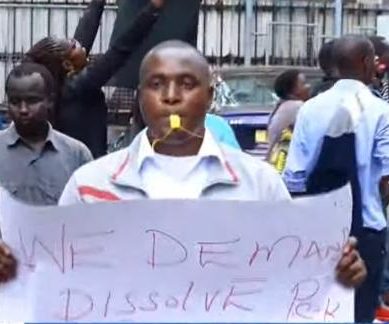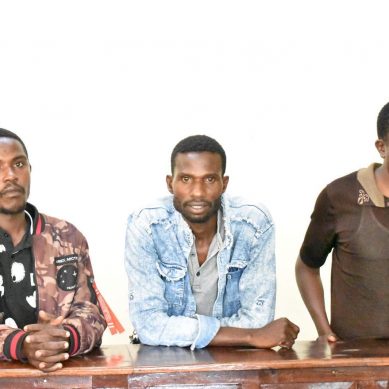
As Uganda’s leaders in the executive and the legislature fidget with encroaching on the Uganda People’s Defence Forces (UPDF) Act in order to ensure that civilians continue to be tried in military courts if they are found with guns, the falsehood that guns constitute the greatest threat to our security continues to mushroom in the high echelons of power.
This has meant that a lot of time, energy and money are allocated to containing gun-related insecurity. However, climate swings and mental illness promise to be the greatest worry for the highest number of Ugandans.
Unfortunately, the threats of climate swings and mental illness continue to receive the slightest attention from the planners and executers of our security at the highest level of political and military decision-making in the country. It is an agony to reduce all security to physical security mediated by the gun. It is a falsehood. It leaves other types of security insignificant in our security equation, thereby making our total security insecure.
In this article, I want to discuss the threat of mental illness in our security. As I write, Uganda does not seem to have an effective law to address mental illness related security, which may or may not involve guns.
Mental illness is rapidly rising and affecting Ugandans across all social strata, although a lot of studies need to be carried out to establish the differential levels between the social levels. It would be dangerous if mental illness proliferates among our security organs. It would explain why gun-wielding soldiers, policemen and intelligence officers are becoming a great threat to the physical security of Ugandans.
During the opening of mental health month (May, 2022), officials from Uganda’s ministry of health stated that about 14 million people of the 43·7 million population have a mental illness. The approximate prevalence of about 32·0 per cent was higher than in previous national estimates of 24·2 per cent; the prevalence might be higher due to the pervasive social stigma and taboos associated with accessing mental health services and the impact of the Covid-19 pandemic (Kaggwa, et. al. 2022).
There is a silent mental health crisis not only among men (BMJ Global GH Blogs, 2023) but also among women and children across different age groups. Unaddressed mental health disorders can exacerbate substance abuse, domestic violence and even lead to suicide. When men suffer silently, it creates a ripple effect that impacts their relationships, productivity, and overall well-being. (MBJ GH Blogs, 2023).
In Uganda, children make up about half (56 per cent) of the total population, and they often present with multiple physical, mental health, and educational challenges. Large numbers of Ugandan children live in communities with high rates of chronic poverty (38 per cent), domestic violence (30 per cent), physical violence toward children (80 per cent), depression (33 to 39 per cent), malaria (70 to 80 per cent) and HIV or Aids (6 per cent). All these factors require thoughtful policy interventions that will allow Ugandan children the opportunity to thrive and lead healthy and productive lives (Policy Report Prepared for the Parliament of Uganda, 2018).
Mental health challenges that emerge during childhood and adolescence may compromise healthy transition to adulthood and increase economic and social costs for families, governments and society in general. For instance, childhood disruptive behaviour disorders, if not addressed, are associated with adverse outcomes, including academic problems (e.g. school dropout), social impairment, a higher incidence of chronic physical problems, unemployment and legal problems, substance abuse and violence as adults (Policy Report Prepared for the Parliament of Uganda, 2018).
Moreover, studies show that a substantial proportion of mental health challenges in adults originate during childhood and adolescence. Hence, addressing mental health challenges in early developmental stages has been set as a priority for the global child health agenda (Policy Report Prepared for the Parliament of Uganda, 2018).
During epidemics such as Covid-19 five years ago, people can develop mental problems. Studies conducted in Uganda reported high levels of psychological distress, depression and anxiety among various groups during the Covid-19 epidemic. Mental health and psychosocial support are vital in epidemic and pandemic responses, underscoring the need for health systems to equip themselves to address emergent mental health challenges, while also ensuring ongoing support for those with pre-existing mental health conditions (Anita Arinda, et al, 2024).
On the whole mental disorders threaten to collectively constitute the greatest security threat in Uganda. Mental illness occurs on a scale of 1-10. One is extremely sick towards 10. Besides, one’s mental health may swing from 1 to 10 and back. In that case, moods may swing wildly. A person may be calm in the morning but violent at night. Way back in early millennium someone knowledgeable about mental health issues told me that of the four people in front of me on any street of Kampala one may be tending towards 10 on the scale. That sounded threatening. I imagined that that could also be the case among a group of soldiers or policemen seeking to control the movements and actions of Ugandans. I thought about the consequences of unsuspecting citizens clashing with such a group.
Many deaths are being caused by mentally sick people, either to themselves or others. Apparently, the majority do not use guns to commit crimes. They use objects like knives, pangas, nails, stones, nail cutters, et cetera. In most urban, periurban and rural areas, the mentally sick constitute the greatest security threat to Ugandans than gun-wielding criminals.
There is need to take mental health related issues far more seriously than before and allocate adequate time, energy and money to confronting them in Uganda. Govern must de-mystify gun-related security and release funds unfairly allocated to gun-caused insecurity to fund mental health security and other types of security adequately. For lack of space, I have excluded other types of security that need to be taken seriously such as ecological security, environmental security, and climate security. Many people have lost their land to grabbers of land, more frequently of exogenous origin, and emerged as mentally deranged people when they have found themselves displaced and unable to connect with their ancestral lands to farm and support their families.
Unsupported children have consequently become mentally deranged. Therefore, mentally sick people in Uganda are today mainly internally displaced people. As things are, state guns are likely to point at than protect them even when their mental faculties are not serving them well. In that case, they are foreigners in their own country and biological substances.
Yes. The agony of reducing all security to physical security is real! It is not too late to rethink security in Uganda and redirect the National budget to intelligently address all dimensions of security in Uganda adequately. So much money continues to be wasted in administration and politics.
For God and my country.
- A Tell report / By Oweyegha-Afunaduula / Environmental Historian and Conservationist Centre for Critical Thinking and Alternative Analysis (CCTAA), Seeta, Mukono, Uganda.
About the Centre for Critical Thinking and Alternative Analysis (CCTAA)
The CCTAA was innovated by Hyuha Mukwanason, Oweyegha-Afunaduula and Mahir Balunywa in 2019 to the rising decline in the capacity of graduates in Uganda and beyond to engage in critical thinking and reason coherently besides excellence in academics and academic production. The three scholars were convinced that after academic achievement the world outside the ivory tower needed graduates that can think critically and reason coherently towards making society and the environment better for human gratification. They reasoned between themselves and reached the conclusion that disciplinary education did not only narrow the thinking and reasoning of those exposed to it but restricted the opportunity to excel in critical thinking and reasoning, which are the ultimate aim of education. They were dismayed by the truism that the products of disciplinary education find it difficult to tick outside the boundaries of their disciplines; that when they provide solutions to problems that do not recognise the artificial boundaries between knowledges, their solutions become the new problems. They decided that the answer was a new and different medium of learning and innovating, which they characterised as “The Centre for Critical Thinking and Alternative Analysis” (CCTAA).
Further reading
Anita Arinda, Kenneth Kalani, Emmanuel Mpamizo, Raymond Sebuliba, Vanessa Akinyange, Sarah Lofgren (2024). Pan African Medical Journal, Vol 48, 2 July 2024. https://www.panafrican-med-journal.com/content/article/48/84/full/ visited on 1 March 2025 at 912
BMJ GH Blogs (2023). The Silent Mental Health Crisis among men in Uganda BMJ Global Health, October 22 2023. https://blogs.bmj.com/bmjgh/2023/10/22/the-silent-mental-health-crisis-among-men-in-uganda/ Visited on 01 March 2025 at 08:46 am EAT
Kaggwa, Mark Mohan et al. (2022). The Lancet Psychiatry, Volume 9, Issue 10, 766 – 767 https://www.thelancet.com/journals/lanpsy/article/PIIS2215-0366(22)00305-4/fulltext Visited on 01 March 2025 at 08:34 am EAT.
Kigozi, F ∙ Ssebunnya, J ∙ Kizza, D ∙ et al. (2010). An overview of Uganda’s mental health care system: results from an assessment using the World Health Organization’s Assessment Instrument for Mental health Systems (WHO-AIMS). Int J Ment Health Syst. 2010; 4:1.
Kalungi, Allan, et.al. (2025). Kalungi, A., Kinyanda, E., Akena, D.H. et al. Prevalence and correlates of common mental disorders among participants of the Uganda Genome Resource: Opportunities for psychiatric genetics research. Mol Psychiatry 30, 122–130 (2025). https://doi.org/10.1038/s41380-024-02665-8.
POLICY REPORT PREPARED FOR THE PARLIAMENT OF UGANDA (2018). Child and Adolescent Mental Health Care in Uganda. Combined-2018- Policy Brief-pdf. https://ichad.wustl.edu/wp-content/uploads/2020/01/Combined-2018-Policy-Brief.pdf visited on March 2025 at 9:07 am EAT.







